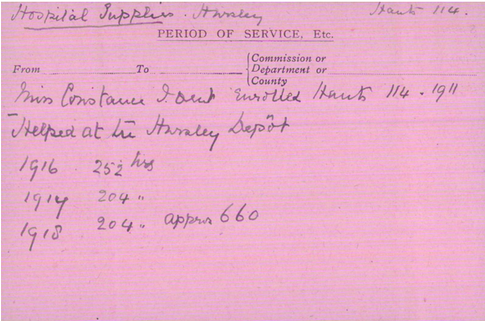Hursley's women during World War I
- David Key
- Oct 27, 2016
- 4 min read


The sacrifices made by the men, whether those who came from Hursley or those who simply passed through, has inevitably been the main focus of how The Great War has been remembered. However, it is also worth reflecting on the role that the women, young and old, played. Like the men, there were those from the village who served: sometimes in the village, sometimes far away; some as part of the "war service" that had mobilized the nation like never before, and there were those who came to Hursley from afar and briefly called Hursley their home.
The first role the women of Hursley played was as hosts to the officers and families of the soldiers who formed the new Divisions at Hursley in the autumn and winter of 1914. Taking in lodgers was not unusual but it was never so important as at this time. In Ladwell the Hayes family took in the wife of Captain Ralph Verney of the Rifle Brigade, and it was from their doorstep she waved farewell to her husband as he marched with his men from Hursley to the port at Southampton and onto France. But it was to be in a more direct way that most played their part.

Following the Boer War the need for trained nurses had become evident and in 1909 the Government began to encourage the formation of Voluntary Aid Detachments. Although not an exclusively female organisation it proved to be popular, particularly amongst the middle classes. Training was basic but by the beginning of the War Hursley could boast three detachments all trained in First Aid, Nursing, Cookery, Stretcher and Field Work. Under the control of the British Red Cross Society and Order of St John of Jerusalem these new Detachments were soon pressed into service as Hospitals sprung up to cope with the casualties returning from France. So closely associated with their work did these volunteers become that soon they were simply called V.A.D.s.
Although one might expect their First Aid and Nursing training to have stood them in good stead, initially they were treated very much as menial staff.
At Hursley Lady Cooper’s Hospital for Officers was managed by professional nurses like Matron Lilian Boughey, a member of Queen Alexander’s Imperial Military Nursing Service (Reserve), and Sister Elizabeth Ramage of the Civil Nursing Service. For these professional nurses the volunteers were often considered fit for little more than cleaning, cooking and other jobs associated with domestic services.
For those from the village for whom a life in ‘service’ was all that they would have expected such work was entirely normal, but many found themselves posted far from home. A few years before the War Kate Burton had been at school in Hursley and living with her family at 125 Lower Shawland. By 1917 the Red Cross shows her working as a Pantry Maid at an Auxiliary Hospital in Surrey and then a Military Hospital on Salisbury Plain. Others from the Hursley Detachments served at Hospitals in Winchester, Southampton and beyond.
Many of the VADs were from a genteel, middle-class background for whom service was an entirely new experience. The Red Cross records for Hursley show how far this social divide was maintained.

While Kate had simply swapped domestic service in a wealthy household to that in a military hospital Miss Constance Dent, from Red House at Ladwell and who had been the Commandant of one of the pre-war Hursley Detachments (Hants. 114), had her service described as “Helped at the Hursley Depot” where she dealt with Hospital Supplies and her service hours for 1916-1918 show her only working 4-5 hours per week.
In contrast the Hursley Park Military Hospital brought many young women to the village from across Britain, including Susan Blair from Braehead in Fife, who worked as a Clerk, and Evelyn Denley from Worcestershire who worked as a Driver in the US Hospital. These roles reflected the changing importance of the role of the women in Hursley. As more and more men volunteered or were conscripted so the role of women changed from traditional domestic duties to take on male roles like clerical workers and motor transport. So respected was the work they did that in 1917 the Womens’ Army Auxiliary Corps was formed, amongst them Mabel Fulbrook from Twyford in Berkshire who worked in the Hursley military hospital.

1917 also brought the Royal Flying Corps to Hursley. For the RFC Cadets the W.A.A.C. ladies supply of tea on white table cloths was a touch of class they had not experienced at Farnborough. For the ladies of the Women’s Legion who helped, the number of earwigs in Hursley seemed the most pressing issue! Alongside them Edie Walker, from nearby Twyford, was working as a clerk with her sister. In April 1918 the RFC became the RAF and with them the Edie became a founder member of the Womens’ Royal Air Force and properly became a part of the armed forces.

By May the RAF had moved to Worthy Down and their place taken by the US army and their Base Hospital, staffed by professional nurses mainly from Iowa in the US, but still supported by a large number of British nurses and staff including in the kitchens Florence Hearn from London.
In the four years of war Hursley played its part and, like elsewhere, it was through the labour, dedication and skill of the women who served that this was possible. As the war progressed the range of tasks they were asked to perform increased and played a significant part in convincing the government to grant limited suffrage to women at the end of the war, achieving what neither the gentle persuasion of the Suffragists or violent protests of the Suffragettes could.


































Comments